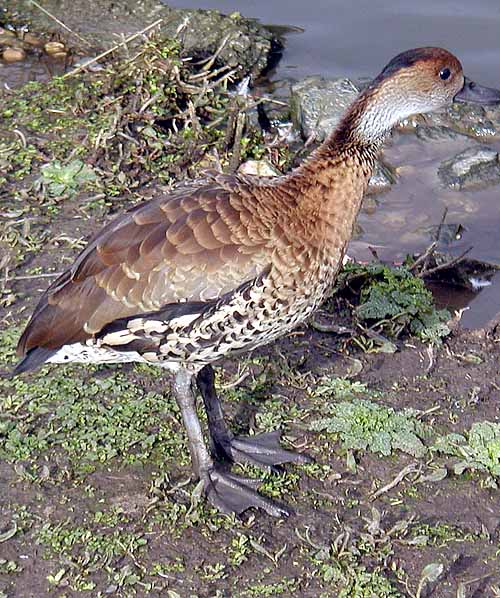- Black-billed Whistling Duck
Taxobox
name = Black-billed Whistling Duck
status = VU | status_system = IUCN3.1
trend = down

image_width = 200px
regnum =Animal ia
phylum = Chordata
classis = Aves
ordo =Anseriformes
familia =Anatidae
genus = "Dendrocygna "
species = "D. arborea"
binomial = "Dendrocygna arborea"
binomial_authority = (Linnaeus,1758 )The Black-billed Whistling Duck, "Dendrocygna arborea", is a
whistling duck which breeds in theWest Indies . Alternative names are West Indian Whistling Duck and Cuban Whistling Duck.The Black-billed Whistling Duck is widely scattered throughout the West Indies including a large breeding population in the
Bahamas , and smaller numbers inCuba , theCayman Islands ,Antigua and Barbuda , andJamaica . It is largely sedentary, apart from local movements which can be 100 km or more. Nests have been reported in tree cavities, on branches, in clumps of bromeliads, and on the ground under thatch palms and other dense bushes. The usual clutch size is 10-16 eggs. It habitually perches in trees, which gives rise to its specific name.The birds are mostly nocturnal and secretive, inhabiting wooded swamps and mangroves, where this
duck roosts and feeds on plant food including the fruit of theRoyal Palm .The Black-billed Whistling Duck is the largest (48-58 cm) and darkest of its genus. It has a long black bill, long head and longish legs. It has a pale foreneck and light brown face. The crown, back, breast and wings are dark brown to black, and the rest of the underparts are white with heavy black markings.
All plumages are similar, except that juveniles are duller and have a less contrasted belly pattern.
Threats
The Black-billed Whistling Duck has suffered extensive hunting for its eggs and for sport.
Wetlands are a very limited habitat in theCaribbean , with continuing conversion for development and agriculture. More than 50% of remaining wetlands are seriously degraded by the cutting of mangroves and swamp-forest, pollution (especially over-use of pesticides1) and natural catastrophes such asdrought s andhurricanes .Predation is inadequately documented but may be a factor.Current conservation measures
CITES Appendix II. CMS Appendix II. It is legally protected throughout much of its range, but law enforcement is inadequate.N. L. Staus (1997) The West Indian Whistling Duck Working Group initiated a conservation programme in 1997.L. G. Sorenson (1997) There are several protected areas in the region but, in general, suitable habitat, especially wetlands, is under-represented.N. L. Staus (1997)Proposed conservation measures
Conduct extensive surveys to assess numbers and distribution; assist local authorities in establishing a long-term monitoring programme; conserve key sites; enforce legal protection; initiate public education and awareness programmes. Staus (1997)
References
* Database entry includes a range map and justification for why this species is vulnerable
* "Wildfowl" by Madge and Burn, ISBN 0-7470-2201-1
* Staus, N.L. 1998. Behavior and natural history of the West Indian Whistling Duck on Long Island, Bahamas. "Wildfowl" 49: 194-206.External links
* [http://www.birdlife.org/datazone/search/species_search.html?action=SpcHTMDetails.asp&sid=353&m=0 BirdLife Species Factsheet.]
*ARKive - [http://www.arkive.org/species/GES/birds/Dendrocygna_arborea/ images and movies of the West Indian whistling-duck "(Dendrocygna arborea)"]
Wikimedia Foundation. 2010.
